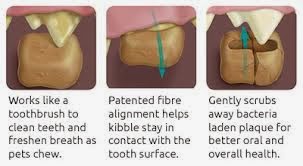 |
| Not all unsightly teeth are correctable! |
Cats have a different sort of problem. Feline Odontoclastic Resorptive Lesions (FORLs) is the more accurate description for feline cavities. FORLs are basically openings or holes in the tooth. FORLs are usually found on the outside surface of the tooth where the gum meets the tooth surface but they can and usually do extend down the tooth root under the gumline. They are unable to be "fixed" with fillings and the affected teeth are not salvageable. Extraction of the diseased tooth is the only solution. And we do need to extract and fix the problem. Why, you ask?

Pain.
Pain.
Pain.
The lesions are exquisitely painful. If you have ever had an open cavity, or root canal, the nerve in the canal is directly exposed to outside stimuli. Every breath of air, every bite of foot, every slight pressure on the lesion is scraping that nerve. The nerve is so reactive that there is a "chattering" response to any stimuli that can be induced even when kitty is under a general anesthetic!
What do FORLs look like?

Above the gumline they are usually hidden by overgrowths of gum that are the body's attempt to cover up that nerve exposure. However that gum is inflamed and doing as poor a job patching the hole as bubble gum on an inner tube.
Under the gumline is usually even more disease. A tooth that appears completely normal "up top" can be rotting away underneath. Teeth affected this way will eventually snap off and leave a ragged, jagged stump to further irritate kitty's mouth.
 |
| Extreme tooth resorption seen in an xray |
So, you ask, where do FORLs come from, what causes them?
Unfortunately we don't really know that answer. Lots of causes have been proposed but none have really been proven. FORLs seem to be a congenital problem, meaning that a cat is predisposed to FORLs from birth. Of my cats, Millie has had multiple FORLs while Petunia had none. Same household, same dental care (home and veterinary) and same diet--different genetics.
So what do we do? Well this is a big problem, affecting an estimated 20 to 60 percent of all cats and close to three-quarters of those five years of age and older. Routine check ups with your veterinarian will help diagnose this condition early and can save your kitty friend years of debilitating pain. A basic oral examination will usually indicate a "up top" problem, and when kitty is having her comprehensive oral exam, cleaning and radiographs (xrays), problems under the gumline can be diagnosed and treated.
What happens if your kitty has to have an extraction? Extractions are performed surgically by your veterinarian with appropriately cat-sized dental instruments, balanced anesthesia, and, of course, pain control. Pain control can be many things, but will almost always include perioperative opiods (morphine and morphine like drugs) and usually local anesthetics.
Afterwards, there is a brief healing period where your kitty should only eat soft or softened food. After the extraction sites are healed, the only change in your cat's day to day life is to be free of PAIN! There are many old kitties out there without any teeth left who eat like champions, though I suspect they wouldn't be very good mousers.
As always, the best veterinary care for your cat is accomplished by regular physical exams and consultations with your veterinarian!











